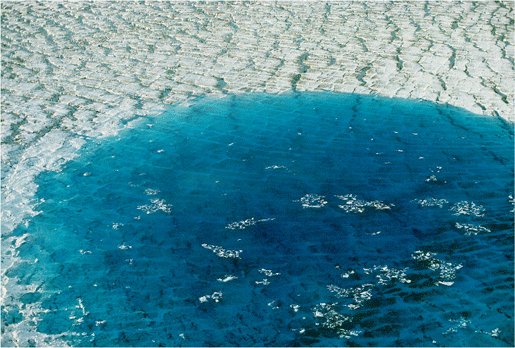I was expecting a dusty road, a saloon door swinging, two geologists standing facing each other in spurrs and cowboy hats with their hands twitching at their sides, both ready to whip out their data and take down their opponent with one well-argued conclusion.
Sadly (for me), things were much more friendly at Professor Pete Nienow‘s seminar in Bristol’s Geographical Sciences department last week. Twelve years ago he visited the University with a controversial hypothesis, causing considerable debate with members of the department. Now he was back, Powerpoint at the ready, to revisit the theory.
Professor Nienow is a glaciologist at the University of Edinburgh. He is currently researching glacial movement and mass in Greenland, but I’ll let him tell you more.
Pete Nienow – GeoScience from Research in a Nutshell on Vimeo.
The Greenland ice sheet covers almost 80% of the country, enclosed by mountains around its edges. The ice sheet is dynamic; glaciers are constantly moving down from the summit towards the sea but replaced each winter by snow. Glaciers are funnelled through the mountains in large “outlet glaciers” that either melt or break into icebergs when they reach the sea.
There is plenty of evidence to suggest that the outlet glaciers are speeding up, rushing down to meet the sea almost twice as fast as they did in the 1970s. Unfortunately that means more melting icebergs floating around, contributing to sea level rise. The winter snowfall is not able to replenish this increased loss of glacial mass, so the Greenland ice sheet is slowly shrinking.
 |
| Coverage of the Greenland ice sheet in different future climate change scenarios. A critical tipping point could be reached, after which it will be impossible to stop the ice from melting and raising sea levels by seven metres globally. Source: Alley et al., 2005 (Science) |
Controversy
Professor Nienow stirred up a debate in 2002, when he proposed that the Zwally Effect could be hugely important for the Greenland ice sheet. This theory suggests that meltwater could seep down through the glacier to the bedrock, lubricating and speeding up the glacial movement.
The conventional wisdom of the time was that it would be impossible for meltwater to pass through the 2km of solid ice that comprises most of the Greenland ice sheet. The centre of the glacier is around -15 to -20°C, so the just-above-freezing water would never be able to melt its way through.
Meltwater research
Meltwater on glaciers often pools on the surface, creating supraglacial lakes. These lakes can drain slowly over the surface, but Professor Nienow found that they can disappear rapidly too. The water slips down through cracks in the ice to the bedrock, leading to a rapid spike in the amount of meltwater leaving the glacier.
 |
| Supraglacial lake. Source: United States Geological Survey, Wikimedia Commons |
Meltwater can reach the base of the glacier so that’s one point to Nienow, but can this actually affect the movement of the glacier?
During the summer, the higher temperatures lead to increased glacial melting, which drains down to the bedrock. This raises the water pressure under the glacier, forcing it to slide more rapidly. Interestingly, as the season progresses, Nienow found that the meltwater forms more efficient drainage channels beneath the glacier, stabilising the speed of the ice.
Nienow was almost ready to mosey on back to Bristol, show them how subglacial meltwater had clear implications of glacier loss for a warmer world, and declare himself the Last Geologist Standing.
Turning point
Glaciologists had always assumed that the winter glacier velocity was consistently low. However, at the end of a very warm 2010, Nienow and his colleagues discovered a blip of especially low speeds, even slower than the standard winter “constant”.
The large channels underneath the glaciers formed by the extra meltwater of that hot year actually reduced the subglacial water pressure during the winter, slowing the glacier more than on a normal year. Nienow found that this winter variability is critical for overall glacier velocity and displacement. In 2010, the net effect of both summer and winter actually meant that the glacier velocity was reduced in this hot year.
Back to Bristol
Nienow returned to Bristol to give his seminar. Somewhat unlike a cowboy film, Nienow concluded that it was a draw; he’d been right that it was possible for meltwater to seep down to the bedrock and lubricate glacial movement, but his friends at Bristol had been correct in thinking that it wasn’t very important in the grand scheme of things.
A collaborative paper between Professor Nienow, the Bristol team and other glaciologists from around the world found that subglacial meltwater will only have a minor impact on sea level rise, contributing less than 1cm of water globally by 2200. Surface run off and the production of icebergs will continue to play a bigger role, even in a warming world. The computer models used to predict sea level rise will be able to include these findings to give a more accurate insight into future glacier movement and coverage across Greenland and beyond.
Bristol glaciologist Dr. Sarah Shannon, lead author on the paper, pointed out that whilst overall glacier velocity is unlikely to be affected by subglacial meltwater in warm years, “global warming will still contribute to sea level rise by increasing surface melting which will run directly into the ocean”.
 |
| Sarah Jose |
